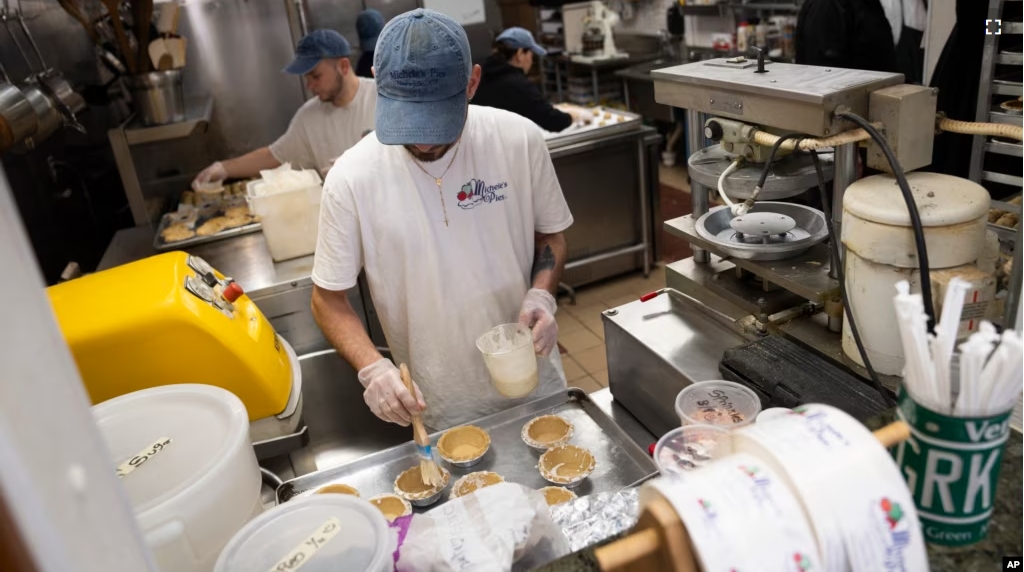Math lovers celebrate Pi Day on March 14, or 3/14. Around the world, many people even mark the day by eating a tasty piece of pie.
For those who do not know, pi is a mathematical constant, a value that never changes. It expresses the ratio of a circle’s circumference (the distance around the circle) to its diameter (the distance across the circle, passing through its center.)
The approximate value of this mathematical constant is 3.1415926535. But those are just the first 10 digits of pi. The numbers go on infinitely, or forever.
Pi can calculate the circumference of a circle by measuring the diameter and multiplying that by the 3.14-plus number. The formula has been used in physics, astronomy, engineering and other fields, dating back thousands of years.
Long before computers, scientists such as Isaac Newton spent many hours calculating decimal places by hand. But today, researchers use computers to come up with trillions of digits for pi. But there is no end.
What are some practical uses for Pi?
There are many uses for pi.
The number helps calculate the size of paper rolls used in printers. And it helps decide the necessary size of a container that serves heating and air conditioning systems in buildings of different sizes.
Scientists use the number to point an antenna toward a satellite and calculate the orbits and positions of planets and other space bodies.
Scientists with the American space agency NASA use pi to calculate when parachutes should open as a vehicle splashes down on Earth or lands on Mars.
Pi Day
In 1706, British mathematician William Jones began using the Greek letter pi for the number 3.14… It is the first Greek letter in the words “periphery” and “perimeter.” Both words have similar meanings as circumference.
Pi Day itself dates back to the year 1988. That was when physicist Larry Shaw began celebrations at the Exploratorium, a science museum in San Francisco, California.
The so-called holiday did not gain national recognition until more than 20 years later. In 2009, the U.S. Congress declared every March 14 to be Pi Day as a way to bring more interest in math and science.
The San Francisco museum that started the holiday organizes events, including a walk around a circular sign, called the Pi Shrine, 3.14 times. Of course, there is also plenty of pie to eat.
Many Pi Day events take place at colleges in the United States. For example, Nova Southeastern University (NSU) in Florida holds the “Mental Math Bingo” game with free pizza pies.
Jason Gershman oversees NSU’s math department. He said, “Every year, Pi Day provides us with a way to celebrate math, have some fun and recognize how important math is in all our lives.”
NASA has its yearly “Pi Day Challenge” online. The space agency offers games and puzzles, such as calculating the orbit of an asteroid or the distance a moon rover would need to travel each day to study a certain lunar area.
If you still wonder why Pi Day is such an important day for math lovers, here are two more reasons: Albert Einstein, possibly the world’s best-known scientist, was born on March 14, 1879. And famed physicist Stephen Hawking died on March 14, 2018, at age 76.
Although pi is not a perfect number. Hawking once had this to say: “One of the basic rules of the universe is that nothing is perfect. Perfection simply doesn’t exist. Without imperfection, neither you nor I would exist.”
And Happy Pi Day!
I’m Jill Robbins
Hai Do adapted this story for Learning English based on an Associated Press news report.
______________________________________________
Words in This Story
pie – n. food that consists of a crust filled with fruit, meat, etc.
approximate -adj. almost correct or exact
digit – n. a written symbol for any of the numbers 0 to 9
ratio – n. the relationship between two things and that is often represented by two numbers
formula – n. a general fact or rule
calculate – v. to find an answer or number using the math process
parachute – n. equipment made of cloth that is fastened to people or things and that permits them to land safely from the air
puzzle – n. question or problem that requires skill to solve
